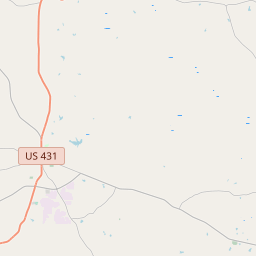Bluffton-Lanett, Alabama
Historical marker location:
105 N Lanier Ave, Lanett, Alabama
( Marker is at the intersection of North Lanier Avenue and 1st Street, on the left when traveling north on North Lanier Avenue.)
Marker installed: 1979







© OpenStreetMap contributors
Loading...
Searching for other points of interest within 3 miles of this location.Alabama is home to several important civil rights landmarks, including the 16th Street Baptist Church in Birmingham, which was the site of a deadly bombing in 1963, and the Edmund Pettus Bridge in Selma, which was the site of the "Bloody Sunday" confrontation between civil rights marchers and state troopers in 1965.
About Chambers County
Chambers County Timeline
Chambers County, Alabama has a rich and diverse history that stretches back to its early settlement by Native American tribes. European exploration and colonization followed in the late 18th century, with the area becoming part of the Mississippi Territory in 1798. In 1832, Chambers County was officially established as one of Alabama's original 29 counties.
The region's economy has been shaped by various industries over the years. In the early 19th century, textiles and agriculture, particularly cotton, played major roles in Chambers County's development. The county experienced an economic boom during this time, with the construction of numerous mills and a rise in population.
The Civil War had a significant impact on Chambers County. It was caught in the crossfire as Union and Confederate forces vied for control of the region. Several battles and skirmishes occurred within its borders, leaving lasting scars. Following the war, the county faced economic struggles as it tried to recover from the devastation.
In the 20th century, the county experienced some revitalization with the growth of industries like textile manufacturing and automotive production. The establishment of Fort Benning, a military base, in nearby Georgia also brought economic benefits to Chambers County. Today, Chambers County continues to evolve, with a diverse economy that includes manufacturing, agriculture, and services, as well as a rich heritage that is celebrated and preserved.
The region's economy has been shaped by various industries over the years. In the early 19th century, textiles and agriculture, particularly cotton, played major roles in Chambers County's development. The county experienced an economic boom during this time, with the construction of numerous mills and a rise in population.
The Civil War had a significant impact on Chambers County. It was caught in the crossfire as Union and Confederate forces vied for control of the region. Several battles and skirmishes occurred within its borders, leaving lasting scars. Following the war, the county faced economic struggles as it tried to recover from the devastation.
In the 20th century, the county experienced some revitalization with the growth of industries like textile manufacturing and automotive production. The establishment of Fort Benning, a military base, in nearby Georgia also brought economic benefits to Chambers County. Today, Chambers County continues to evolve, with a diverse economy that includes manufacturing, agriculture, and services, as well as a rich heritage that is celebrated and preserved.
Chambers County Timeline
This timeline provides a condensed summary of the historical journey of Chambers County, Alabama.
- 1832 - Chambers County, AL was established on December 18.
- 1833 - The first courthouse was built in LaFayette, serving as the county seat.
- 1834 - The first newspaper, The Chambers County Pioneer, was established.
- 1836 - The county's population grew after the Creek Native Americans were relocated to Oklahoma during the Indian Removal Act.
- 1861-1865 - Chambers County residents participated in the American Civil War on the side of the Confederacy.
- 1886 - The county seat was moved from LaFayette to its current location, LaFayette, to be closer to the Central of Georgia Railway.
- 1909 - West Point Dam and Hydroelectric Power Plant were built on the Chattahoochee River, providing electricity to the county.
- 1930s - The Great Depression affected Chambers County, leading to widespread economic hardships.
- 1942-1945 - Chambers County citizens contributed to World War II efforts, with many serving in the military.
- 1965 - The county played a role in the Civil Rights Movement, as students from LaFayette participated in protests and boycotts.
- 2000s - Chambers County experienced economic growth with the development of Kia Motors Manufacturing Georgia, employing many local residents.